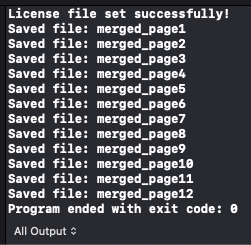Split a Multipage Image File Into Separate Files - macOS Swift Console
This tutorial shows how to load a multipage file and save each page from it to separate image files in a macOS Swift Console application using the LEADTOOLS SDK.
| Overview | |
|---|---|
| Summary | This tutorial covers how to split multipage image files in a macOS Swift Console application. |
| Completion Time | 20 minutes |
| Visual Studio Project | Download tutorial project (5 KB) |
| Platform | macOS Swift Console Application |
| IDE | Xcode |
| Development License | Download LEADTOOLS |
| Try it in another language |
Required Knowledge
Get familiar with the basic steps of creating a project by reviewing the Add References and Set a License tutorial, before working on the Split a Multipage Image File Into Separate Files - macOS Swift Console tutorial.
Create the Project and Add LEADTOOLS References
Start with a copy of the project created in the Add References and Set a License tutorial. If you do not have that project, follow the steps in that tutorial to create it.
The references needed depend upon the purpose of the project. This tutorial requires the following Framework references located at <INSTALL_DIR>\LEADTOOLS23\Bin\Xcode\Frameworks\macOS:
Leadtools.Codecs.Cmp.frameworkLeadtools.Codecs.Png.frameworkLeadtools.Codecs.Tif.frameworkLeadtools.Codecs.frameworkLeadtools.framework
Edit the Leadtools-Bridging-Header.h file to add the following imports:
#import <Leadtools.Codecs/Leadtools.Codecs.h> For a complete list of which files are required for your application, refer to Files to be Included in your Application.
Set the License File
The License unlocks the features needed for the project. It must be set before any toolkit function is called. For details, including tutorials for different platforms, refer to Setting a Runtime License.
There are two types of runtime licenses:
- Evaluation license, obtained at the time the evaluation toolkit is downloaded. It allows the toolkit to be evaluated.
- Deployment license. If a Deployment license file and developer key are needed, refer to Obtaining a License.
Note: Adding LEADTOOLS references and setting a license are covered in more detail in the Add References and Set a License tutorial.
Add the Split Image Code
With the project created, the references added, and the license set, coding can begin.
Using the Project Navigator, open main.swift. Add a new string multipageFile and set it to the multipage image file you wish to split, as shown below.
SetLicense()let multipageFile: String = "<INSTALL_DIR>/LEADTOOLS23/Resources/Images/merged.tif"SplitFile(file: multipageFile)
Note: The code below requires a multipage file, such as a TIFF or PDF file. If you do not have one available, you can create one by following the steps in the Create a Multipage File from Multiple Images tutorial.
Add a new function named SplitFile(file: String) and call it below the string value created above. Add the following code to load the multipage file and export each page as its own image to file.
func SplitFile(file: String) {let codecs: LTRasterCodecs = LTRasterCodecs()var error: NSError?let totalPages: Int = codecs.totalPages(in: file, error: &error)if error != nil {print(error!.localizedDescription)}let fileName = URL(string: file)!.deletingPathExtension().lastPathComponentfor page in 1...totalPages {let outputFile: String = "<INSTALL_DIR>/LEADTOOLS23/Resources/Images/\(page).png"do {let image: LTRasterImage = try codecs.load(file: file, pageNumber: page)try codecs.save(image, file: outputFile, format: LTRasterImageFormat.png, bitsPerPixel: 0)print("Saved file: \(URL(string: outputFile)!.deletingPathExtension().lastPathComponent)")} catch {print(error.localizedDescription)}}}
Run the Project
Clean the project to clear any errors by selecting Product -> Clean Build Folder or Shift + Command + K.
Run the project by selecting Product -> Run or Command + R.
If the steps were followed correctly, the application runs and creates new PNG file for each page of the multipage file.

Wrap-up
This tutorial showed how to add the necessary references to load all the pages of a TIFF image file and split them into separate PNG images using the LTRasterImage and LTRasterCodecs classes.
